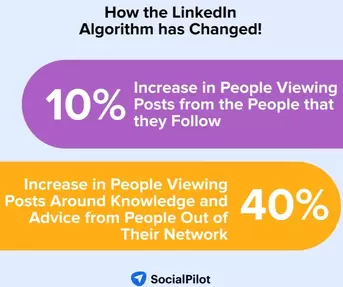 LinkedIn has continued to make algorithm changes focused on content distribution. The latest include the verification badge, adding suggested evergreen posts, changing the format of the posts that are rewarded with higher reach, and a new call to action and newsletter features. The verified badge. Users can now verify their identity on LinkedIn through a variety of methods. Once verified, users get a small badge on their profile. Jurka called it a "trust-builder" that helps you connect with others — but no, your posts don't get more visibility if you're verified. Timeline and Newsfeed Changes: LinkedIn is prioritizing content with lasting value over timely posts. This means that insightful, niche content can have a longer shelf-life and reach a targeted audience over time. Instead of chasing posting trends, LinkedIn encourages users to share their knowledge and insights. This approach is more likely to yield long-term success on the platform. Post Formatting: LinkedIn is moving away from rewarding posts that use clickbait tactics, such as "broetry" (posts with spaces between each sentence), to improve reach. New Features: LinkedIn is developing new Call-to-Action (CTA) button options for user profiles, including a "Subscribe to My Newsletter" option. The platform is also moving away from the term "creator" to better align with the professional title. Also, LinkedIn plans to expand its newsletter product this year. For more details on these changes I found this podcast that will provide more details for each of these algorithm updates. Link to Podcast Thanks for reading. Let me know if you have any questions or additional tips! Kellie Emrich Follow @thesocialprof on Facebook
0 Comments
 What are Chatbots? Chatbots are computer programs designed to simulate conversations with users, often seen as pop-up windows offering assistance on websites. Initially, they could only respond to preset scripts, lacking personality. However, modern chatbots leverage advanced artificial intelligence (AI) to comprehend natural language and provide intelligent responses, mirroring real conversations. They continuously learn and improve from interactions, becoming smarter over time. The journey of chatbots began with ELIZA in 1966, which mimicked a therapist using a predetermined script. Since then, the integration of genuine AI has significantly evolved chatbots, enabling them to learn from real dialogues and enhance their capabilities. Today, chatbots are accessible tools that anyone can use, not just tech experts. They are cost-effective and easy to implement on popular platforms. How Small Businesses Can Benefit from Chatbots:
Thanks for reading. Let me know if you have any questions or additional tips! Kellie Emrich Follow @thesocialprof on Facebook |
Blog Presented by
Dr. Kellie Emrich Archives
April 2024
Categories |




 RSS Feed
RSS Feed